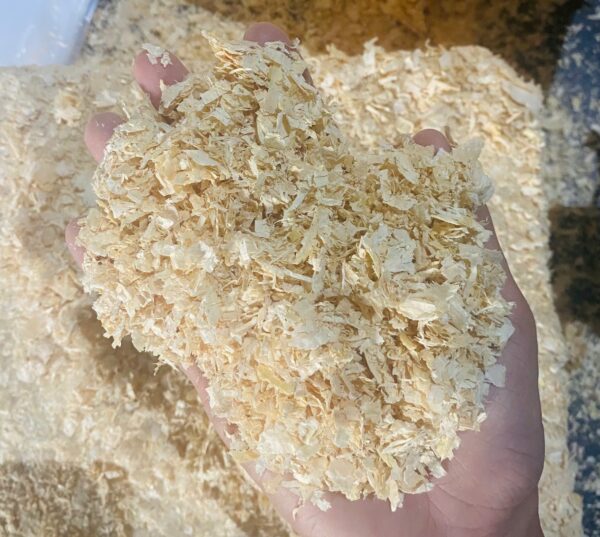Introduction
When setting up a habitat for your reptile, choosing the right bedding is crucial for their health and comfort. Pine wood shavings are a popular option among pet owners, but are they truly safe for reptiles? In this article, we’ll examine the benefits and potential risks of using pine wood shavings for reptile bedding and provide insights into making the best choice for your scaly friend.

Benefits of Pine Wood Shavings for Reptile Bedding
Pine wood shavings can offer several advantages when used as reptile bedding:
1. Absorbency
Pine wood shavings are known for their excellent absorbency. They effectively manage moisture and help keep the habitat dry, which is essential for preventing mold and bacterial growth. This can contribute to a healthier environment for your reptile.
2. Odor Control
The natural properties of pine wood shavings help control odors. The shavings absorb and neutralize unpleasant smells, keeping the enclosure smelling fresher and more pleasant.
3. Comfort and Enrichment
Pine wood shavings provide a soft, natural substrate that reptiles can dig and burrow in. This can enhance their environment and encourage natural behaviors, contributing to their overall well-being.
Potential Risks of Pine Wood Shavings for Reptiles
While there are benefits, it’s important to be aware of potential risks associated with using pine wood shavings:
1. Aromatic Oils
Pine wood contains natural oils that can be irritating to reptiles. These oils, known as phenols, can cause respiratory issues and skin irritation in some species. It’s essential to choose kiln-dried pine shavings, which have lower levels of these oils.
2. Dust
Pine wood shavings can be dusty, and dust particles can lead to respiratory problems for reptiles. Ensure that the shavings you use are low in dust or have been properly processed to reduce dust levels.
3. Potential Allergies
Some reptiles may have allergies or sensitivities to pine shavings. Observing your reptile for any signs of discomfort or health issues is crucial. If you notice any adverse reactions, consider switching to a different bedding option.
Best Practices for Using Pine Wood Shavings in Reptile Enclosures

If you decide to use pine wood shavings for your reptile’s bedding, follow these best practices to ensure a safe and comfortable environment:
1. Choose Kiln-Dried Pine Shavings
Opt for kiln-dried pine shavings, which have reduced levels of aromatic oils and dust. This makes them safer for reptiles and minimizes potential health risks.
2. Maintain Proper Ventilation
Ensure that the reptile’s enclosure is well-ventilated to prevent the buildup of moisture and odors. Proper ventilation also helps reduce the concentration of any airborne dust.
3. Regular Cleaning and Replacement
Clean the bedding regularly by removing soiled shavings and replacing them with fresh ones. This helps maintain a hygienic environment and prevents the growth of mold and bacteria.
4. Monitor Your Reptile’s Health
Keep a close eye on your reptile for any signs of health issues or discomfort. If you notice any changes in behavior, breathing difficulties, or skin irritations, consult a veterinarian for advice.
5. Provide Additional Hiding Spots and Enrichment
Enhance your reptile’s habitat with hiding spots, climbing structures, and other enrichment items. This promotes mental stimulation and helps mimic their natural environment.
Alternatives to Pine Wood Shavings
If you’re concerned about the potential risks of pine wood shavings, there are several alternative bedding options to consider:
1. Coconut Fiber (Coir)
Coconut fiber is a natural, hypoallergenic bedding option that is safe for most reptiles. It’s highly absorbent and helps control odors while providing a suitable substrate for burrowing.
2. Reptile Carpet
Reptile carpets are reusable and easy to clean, making them a practical choice for reptile enclosures. They provide a stable surface and reduce the risk of ingesting bedding material.
3. Paper-Based Bedding
Paper-based bedding is an affordable and dust-free option. It’s also highly absorbent and easy to clean, making it a good choice for maintaining a hygienic environment.
Conclusion: Choosing the Right Bedding for Your Reptile

Pine wood shavings can be a viable option for reptile bedding, provided you choose kiln-dried varieties and follow best practices to minimize potential risks. However, it’s important to consider your reptile’s specific needs and monitor their health closely. If you have concerns about the safety of pine shavings, exploring alternative bedding options can help ensure a comfortable and healthy habitat for your pet.
By understanding the benefits and potential risks of pine wood shavings, you can make an informed decision and provide the best possible environment for your reptile.
